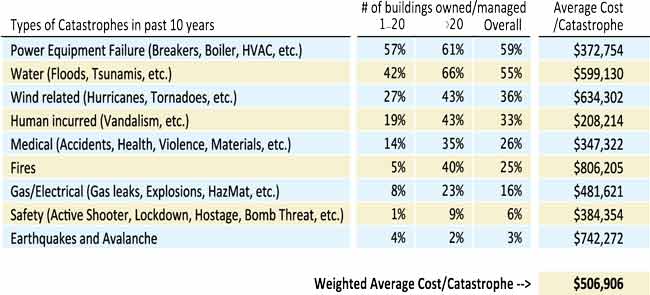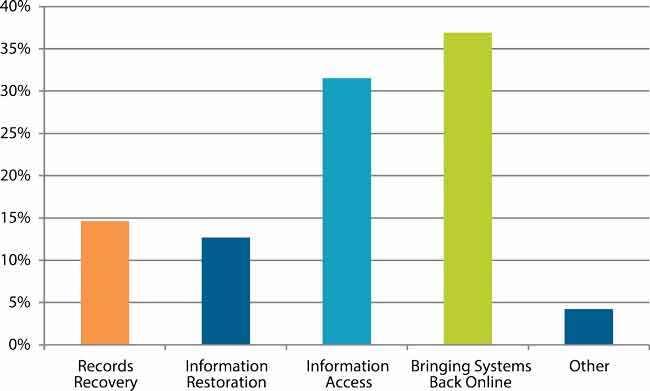« Back to Facilities Management Emergency Preparedness Category Home
When Catastrophes Strike Facilities: Frequency, Costs, Risk Mitigation
March 5, 2018
- Emergency Preparedness
By Todd Moore
Facility teams that manage 20 or more buildings will face a $506,000 catastrophe every 1.7 years, on average, according to new industry insights revealed by the non-profit organization, AIIM Market Research. When developing risk mitigation strategies, most organizations and businesses don't invest the time required to consider the financial implications of emphasizing emergency management. In fact, 81 percent of facilities teams surveyed said they have more work to do to be prepared for a disaster. With the multiple catastrophes that hit the United States in 2017, examining how catastrophes impact facilities in terms of cost and frequency is a timely exercise. By taking it further and applying informed decision-making, research shows that facilities teams can mitigate the risks of disasters using modern methodologies and digital best practices.
Costs for Facilities of All Sizes
In the eBook, Information Management for Facilities and Operation: Knowing Your Gaps is Key to Catastrophe Preparedness, AIIM "defined a facilities catastrophe as 'any unplanned event that costs the organization $150,000 or more.'" AIIM asked respondents to report the number of catastrophes they'd faced in the past ten years.
The research shows that as facility size goes up, so does the frequency (and cost) of catastrophes. Even after averaging the number of buildings under management, catastrophes could still cost organizations $253,000 per year.

When faced with these numbers, it might be easy to allow complacency to prevail, especially for facility managers who've been fortunate not to have experienced a catastrophe. Yet, given the potential cost of a single catastrophe, AIIM vice president Bob Larrivee indicated that "any attempt to rationalize not spending time and money on mitigating the costs of a disaster seems irresponsible."
Many Buildings Equals Higher Frequency
All facilities teams face serious threats from catastrophes, but the data shows that the threat was even more pressing for larger organizations. Naturally, organizations with more buildings have a significant increase in the frequency of catastrophes. In every catastrophe examined, except for "Earthquakes and Avalanches," organizations with 20 or more buildings faced emergencies far more frequently.
For facilities teams managing 20 or more buildings:
● Fires were 8 times more likely.
● Safety events, categorized as active shooters, lockdowns, hostage, bomb threat, etc. were 9 times more likely.
● Water and wind-related catastrophes were, respectively, 24 percent and 16 percent more likely.
● Human-incurred, medical, and gas/electrical catastrophes were all between 2 and 3 times more likely
The average cost of a fire is nearly $300,000 more than the average cost of a catastrophe, indicating that larger facilities teams also face more severe and costly catastrophes.
Hidden Risks of Disasters
There are other hidden costs associated with catastrophes that most organizations have trouble quantifying. For example, water or fire damage is easily calculated. But how does a facilities manager assess, say, the financial implication of reputational damages?
Reputation Damage: Customers and vendors alike may lose confidence in a business or institution after a disaster. Even the most loyal customers might be compelled to switch to a competitor out of necessity and never return. Businesses may be forced to break contracts with vendors, incurring both short and long-term costs.
Regulatory Costs: An organization may also face fines and penalties if it's determined that it wasn't properly prepared for an emergency. It might even be forced to shut down temporarily while doing what's required to achieve compliance with emergency preparation regulations.
Business Interruption Costs: Most businesses, even very successful ones, cannot afford to have their doors closed for a few days, let alone an extended period of time. Yet, even if the organization manages to open its doors and continue operations, it takes time to reach full operational capacity. Businesses running at 50 percent to 75 percent of normal operational capacity for even a few weeks see a negative impact on their bottom line.
Risk Mitigation: Making Informed Decisions
Of course, nothing is going to stop an emergency from occurring. Most of the potential for cost reduction is in mitigating risks and accelerating recovery rather than prevention.
The success of an emergency response and recovery effort depend on the decisions that facility managers make. Since good decisions rely on accurate information, AIIM asked facility teams what their biggest information management challenges were after a catastrophe. The majority of teams say information access (36 percent) and bringing systems back online (37 percent) are their biggest challenges.

Given the current state of facility information storage, it's no surprise that accessing information after a catastrophe is a major challenge. AIIM's research shows that, while most facilities teams do have emergency policies in place, only 14 percent have access to them on a mobile device. Further, less than a third have access to their information in the cloud.
There's no doubt that when information is stored in the cloud it's considered to be more secure and easier to bring back online. Similarly, mobile devices offer a level of accessibility that file cabinets and shared drives simply can't rival.
Together, cloud storage and mobile accessibility address two of the biggest obstacles to being able to make informed decisions during a disaster: 1) accessing critical information, 2) bringing their systems back online quickly.
By implementing a cloud-based technology solution and addressing other hidden risks associated with catastrophes, facilities managers will expand their ability to protect corporate real estate assets and minimize negative financial impacts to the business post-catastrophe.
To learn more about the AIIM survey insights, check out their eBook titled: Information Management for Facilities and Operation: Knowing Your Gaps is Key to Catastrophe Preparedness.
Todd Moore is a national director, facilities solutions at ARC Document Solutions, where he advises facility professionals across the education, healthcare, and government sectors on how technology can transform their operations.










